-
solutinos
-
Hire
Frontend Developer
Backend Developer
-
NodeJS Developer
-
Java Developer
-
Django Developer
-
Spring Boot Developer
-
Python Developer
-
Golang Developer
-
Ruby on Rails Developer
-
Laravel Developer
-
.NET Developer
Technology
-
Flutter Developer
-
React Native Developer
-
Xamarin Developer
-
Kotlin Developer
-
Cross-Platform Developer
-
Swift Developer
-
MongoDB Developer
-
C Developer
-
Smart Contract Developers
Cloud
-
-
Services
Mobile Development
Web Development
- Work
-
Multi Services App
-
Food Delivery App
-
Grocery Delivery App
-
Taxi Cab Booking App
-
Multi Services App
-
OTT Platform APP
-
Social Media APP
-
Freelance Service App
-
Car Rental App
-
Medicine Delivery App
-
Liquor Delivery App
-
Sports Betting App
-
Online Coupon App
-
eLearning App
-
Logistics & Transportation App
-
Courier Delivery App
-
On-Demand Real Estate App
-
E-Wallet APP
-
Online Dating App
-
Handyman Services App
-
-
Process
-
Company
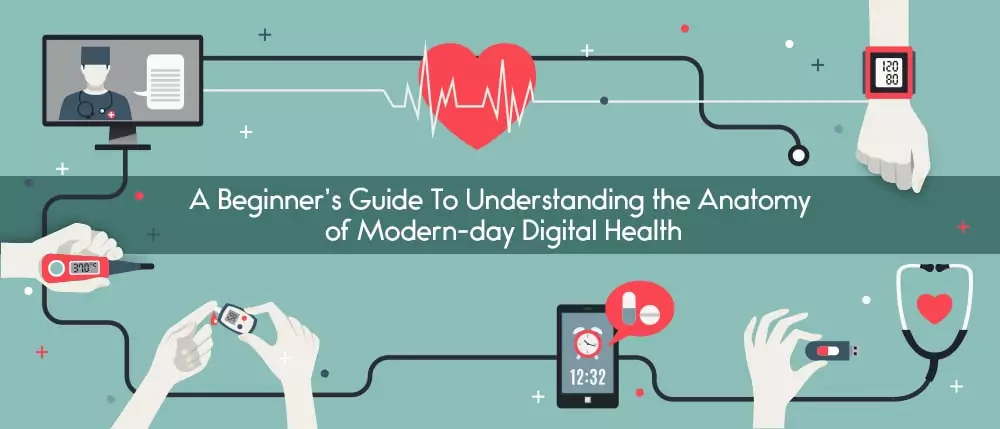
As you read, a new breed of healthcare is evolving at a rate faster than you can imagine. From the time we had to call our clinics or physicians centres and wait for an appointment that would be a week from the time you called, we have evolved into a space where connecting with doctors, specialists, diagnostic centres or any healthcare professional is just a swipe away.
The integration of technology in healthcare has been immensely helpful. We have witnessed this during the pandemic, where digital healthcare arrived as a blessing for most of us. We had our elderly people taken care of by physicians through virtual consultations, medicines getting delivered right to our homes, health insurance policies becoming increasingly accessible and more.
Digital healthcare is here to stay and today’s post is going to be all about it. In our last post, we saw the complexities involved in life sciences and pharma industries and understood their challenges and solutions. Today, we will have a complete walkthrough of the digital healthcare scenario in the world and understand everything associated with it.
So, let’s get started.
What does Digital Health mean?
Before we dive into the intricacies involved in digital health, let’s understand what it is because there seems to be a lot of misconceptions and vague definitions around this. Digital health involves the use of digital technology to facilitate healthcare and all of its allied aspects.
It could be a simple wearable device that you sport like a Fitbit, a doctor on-demand service you use on your smartphone, the concept of electronic health records, AI-based bots in healthcare, robotic arms in surgeries or anything.
The point is to use the capabilities of technology to further elevate healthcare services.
This might seem new but has commercial applications and takers already.
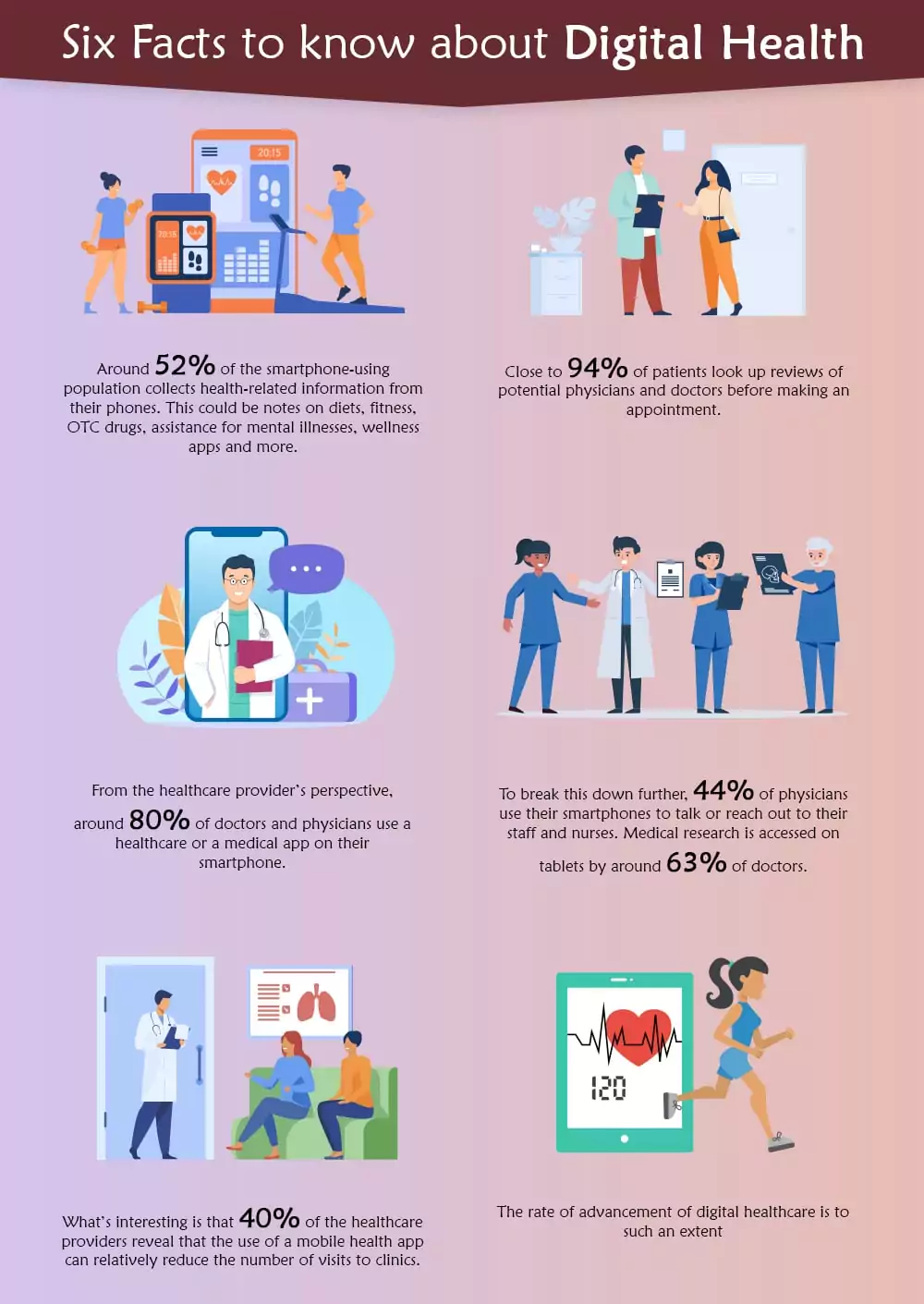
- Around 52% of the smartphone-using population collects health-related information from their phones. This could be notes on diets, fitness, OTC drugs, assistance for mental illnesses, wellness apps and more.
- Close to 94% of patients look up reviews of potential physicians and doctors before making an appointment.
- From the healthcare provider’s perspective, around 80% of doctors and physicians use a healthcare or a medical app on their smartphone.
- To break this down further, 44% of physicians use their smartphones to talk or reach out to their staff and nurses. Medical research is accessed on tablets by around 63% of doctors.
- What’s interesting is that 40% of the healthcare providers reveal that the use of a mobile health app can relatively reduce the number of visits to clinics.
- The rate of advancement of digital healthcare is to such an extent that this segment is expected to become a $536bn market by the year 2025.
Numbers on digital healthcare clearly point to the right direction. And if you’re someone who intends to venture into the digital healthcare spectrum, this post of the series will be extremely resourceful. To help you get a clear picture, let’s refine the different segments in digital healthcare and explore them in detail.
The Anatomy Of the Digital Healthcare Spectrum
Digital Health
Like we mentioned, digital health is the application of Information Technology (IT) to enhance healthcare. There are several ways this is achieved:
- Through user-facing services such as apps
- Through Health Information Technology
- Consumer Health Information
- Telehealth
- Decision Support Software Applications
- Enterprise Support
- And Clinical Care and Administration Tools
User-Facing Technologies
These are applications that users have installed on their devices such as smartphones, tablets and even personal computers. These are designed to deliver seamless and simplified customer experiences and optimum patient care. According to reports, there are over 100,000 healthcare apps on different app stores. Out of these, close to 85% of them are wellness apps and the remaining 15% is constituted by medical apps.
Though apps is a generic term, they are further classified into specialized services which we will explore now.
Lifestyle Apps
Like the name suggests, lifestyle apps are here to complement your lifestyle and help you reach your hygiene, health and fitness goals. They are also inclined towards the wellness of your physical and mental conditions and offer distinct applications or services to support your lifestyle goals.
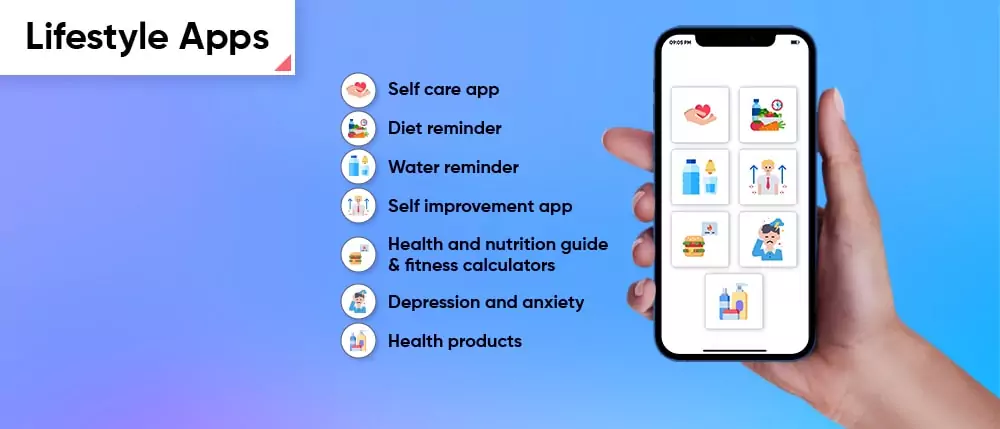
For instance, there are applications like Calm that help you stay relaxed, get a sound sleep, develop mindfulness and help you with guided meditation sessions.
Lifestyle apps cover a range of activities you would indulge in to make your life better and bring in peace of mind in more than one way.
For those of you who didn’t know, lifestyle apps are the 4th most popular apps on app stores.
Fitness Trackers
Fitness tracker apps are the ones that allow you to
- set fitness goals and work on them
- track and monitor progress and results
- get visualization of your progress through analytics
- get recommendation of diet
- know the number of calories you burn
- inform you about your caloric intake based on the food you have and more.
Fitness tracker apps can be further classified into two types:
- Exercise apps
- Activity Tracking Apps
As far as fitness apps are concerned, people want to sue them because of three major psychological reasons:
- They want to stay motivated about their fitness
- They want to track and measure their progress
- They want to monitor their health issues and be warned of them.
That’s why fitness tracking apps come with a lot of variations in the form of logbooks or journaling apps, personal trainer apps, apps that connect with your wearable device such as Fitbit and more.
Quick Case Study
Fitness tracker apps go beyond their purpose of development. The digital healthcare algorithms that were part of Apple Smartwatch’s kept a consistent track of an individual’s vitals and heart rate. With the help of predictive analytics, it accurately predicted the heart attack in the individual minutes before the actual attack and went on to save the man’s life.
Nutrition Apps
Nutrition apps are similar to your fitness tracking apps but differ in the fact that they offer you information on your food and dietary intake instead of your workout and exercise regimens.
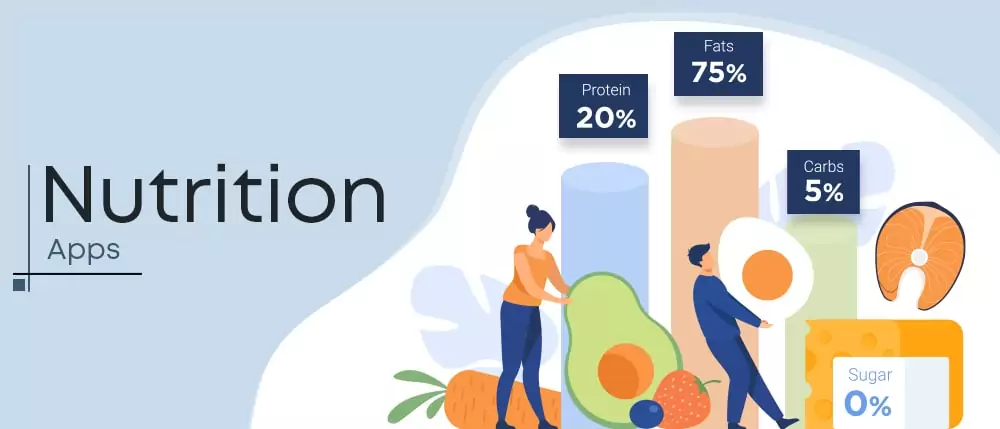
There are nutrition and health apps that give you reliable information on your caloric intake, food items that support your health goals, plan your diet for the week based on your conditions, automatically shop for required ingredients and much more. There are also special apps for keto and vegan enthusiasts.
Apart from holistic nutrition apps, you would also find highly niched apps that keep track of your water intake, caffeine intake, sugar intake and more. These are highly beneficial for people who are constantly working on elevating their lifestyle and becoming healthier.
Medication Reminder Apps
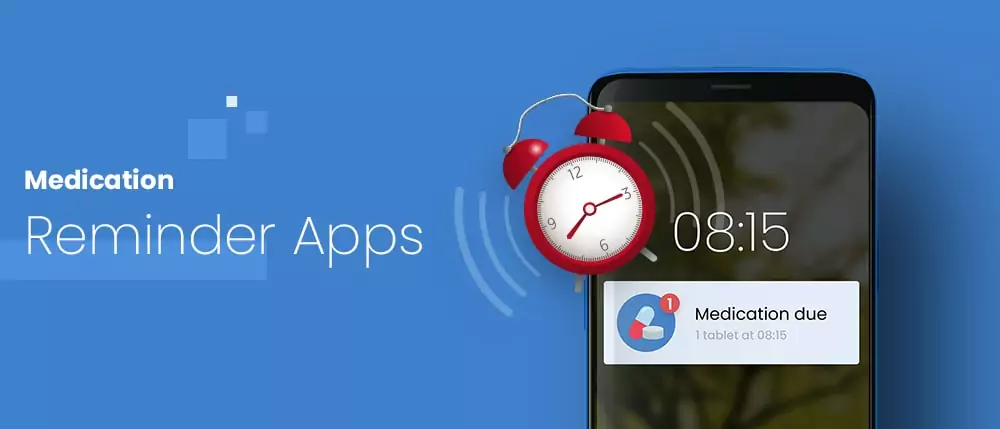
Like the name suggests, these apps remind you to take your pills and medications. For someone newly diagnosed with an ailment, taking medication on time could be a worry. That’s why these apps arrive like an alarm and suggest which medicine to take and when based on your prescription.
For the elderly people living alone, this is the best companion as it lets them take care of themselves without dependencies.
Scheduling Apps
Scheduling apps are contemporary counterparts to the telephones we used to fix our doctor’s appointment from. These apps are advanced in the fact that they are powered by Artificial Intelligence (AI). They help you seamlessly fix appointments with doctors, physicians, diagnostic centres or specialists near you.
The best part about these apps is that you don’t have to wait for your time at the clinic but just reach on time for your appointment. With these apps, rescheduling is also easier and the next patient in cue gets an instant notification about appointment advancement. Again, this is ideal for elderly care and for people suffering from chronic ailments.
Features of User-facing Apps
Health Apps, regardless of what category they fall into, are united by some common features that are inevitable. Be it fitness tracker apps, nutrition apps, lifestyle apps or others, they all would need the following features:
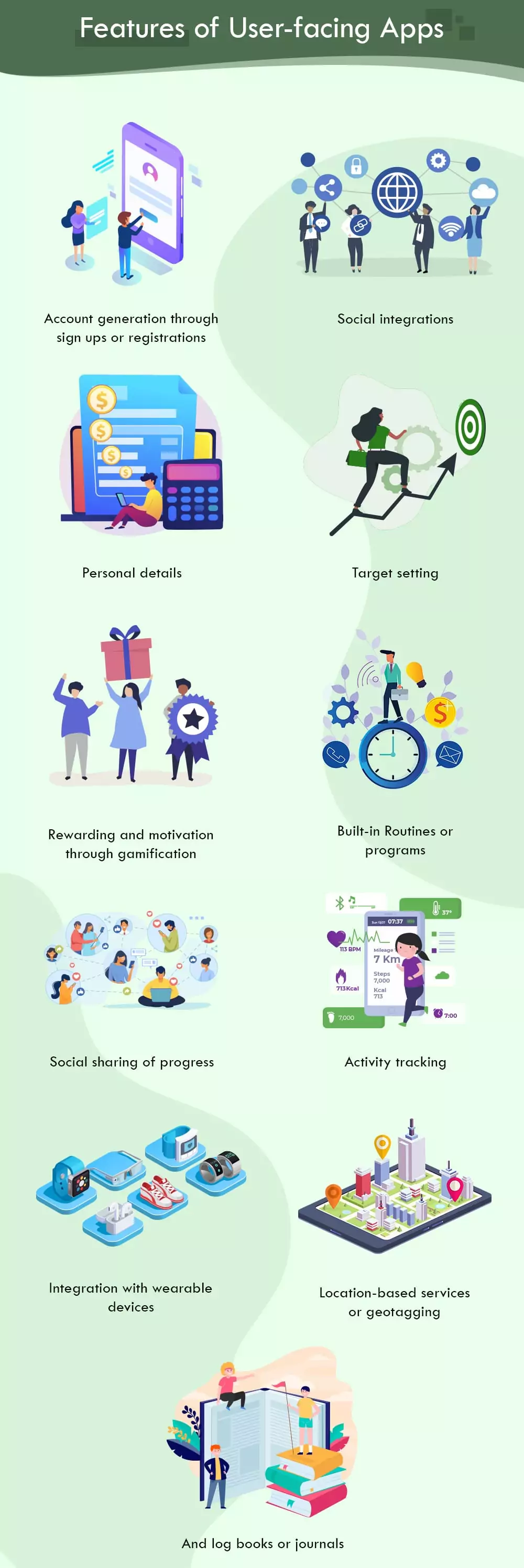
- Account generation through sign ups or registrations
- Social integrations
- Personal details
- Target setting
- Rewarding and motivation through gamification
- Built-in Routines or programs
- Social sharing of progress
- Activity tracking
- Integration with wearable devices
- Location-based services or geotagging
- And log books or journals
User-facing health apps are game-changers today and if you’re someone who wishes to launch a custom app by yourself, we recommend getting in touch with us. Our handpicked developers understand the market like nobody else and we would help you launch the next big health or fitness app in the market.
Health Information Technology
In simple words, health information technology refers to the implementation and leveraging of health information for optimized patient care, treatments and service delivery.
Health information technology has sort of revolutionized healthcare because it has put healthcare in the hands of patients once again. HIT has allowed patients and people to take ownership of their own health and understand that doctors and clinics are secondary dependencies in the healthcare chain and that actual healthcare starts with themselves.
With the advent of data and insights, the void in selfcare has been filled seamlessly.
And this has happened because of the onset of two major entities:
- Electronic Medical Records (EMR)
- Electronic Prescribing and Medical Billing
With the help of HIT mechanisms and their implementations, we are now able to:
- Access, retrieve and modify patient health data from anywhere
- Pave the way for precise diagnosis and treatments because of accurate and updated health information
- Save expenses and time on accessing health files
- Educate and enlighten patients about their health conditions and actively involve them in recovery process and more
Electronic Medical Records
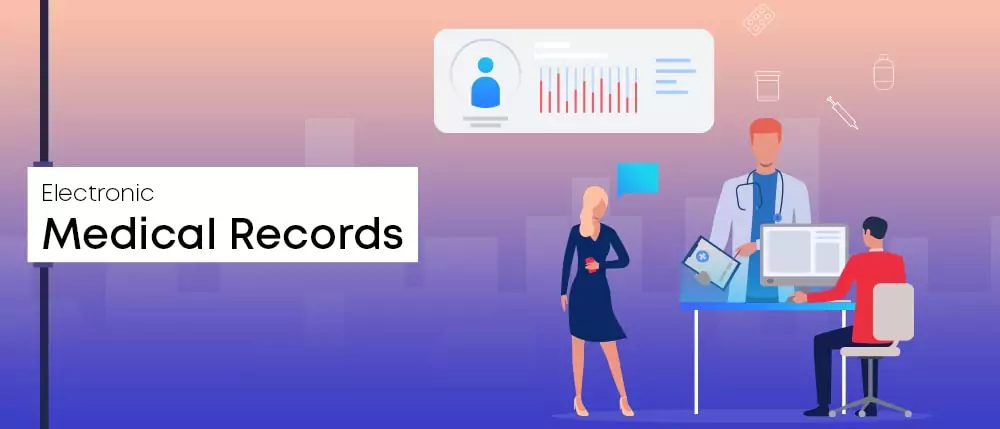
EMRs arrive as the digital off-springs to the age-old record generation and storing mechanisms of paper-and-files. From the time everything was manual and done by hand, EMRs are completely digital and stored on the cloud.
This allows physicians, doctors and any authorized stakeholder from any part of the world to indulge in treatment with just one look. They help streamline processes, coordinate better, segment similar records and patient history for further studies and more. They also help one track improvements, medication impact, compare records, get notified on screening and testing dates and more.
Medical Billing and Electronic Prescribing
Medical billing has to be one of the most redundant and time-consuming tasks in healthcare delivery. With hospitals being busy throughout the year, billing only gets more tedious by the day. And billing is not just a one-time affair, it starts from the time a patient books an appointment for consultation and continues till surgery or treatment is done. The entire chain has to be updated for accurate and error-free billing.
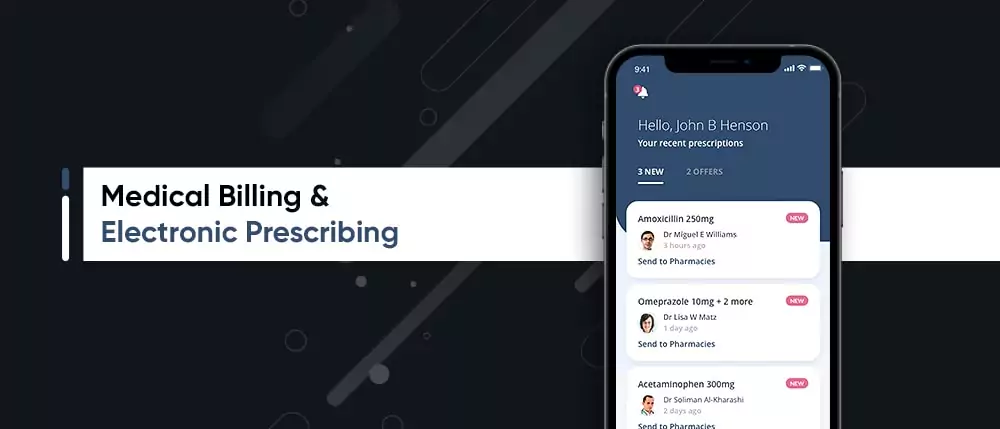
To make this simpler is the concept of medical billing through electronic mediums. These are automation systems – more like the POS systems you would find in retail industries – where a master enterprise application is operated out of a decentralized portal and keeps a record of everything at the backend. These applications help staff process bills, generate invoices, keep track of medical supply-chain, verify insurance claims and do more.
Electronic prescribing, on the other hand, is the digital version of sending prescriptions of doctors to pharmacies manually. While most clinics and hospitals have pharmacies in their own premises, there are a few where they are located outside. In such cases, sending and fetching the right medicines becomes a concern. But with a central portal, all that the staff has to do is assign the EMR number with prescription details and medication would be ready for pickup. The billing can then be added to the overall bill.
This completely removes the process of manually filling forms, updating individual invoices and bills and streamlines the entire process.
The market for health information technology is ripe and it’s the right time to capitalize on the demand. If you intend to get an HIT developed for your venture, get in touch with us today.
Consumer Health Information
The growth of consumer health information systems has been parallel with the growth of the internet. Consumer health information has evolved into what it is today to offer clear and concise information about diseases, ailments, symptoms, cures and remedies to consumers.
Though this does not replace conventional healthcare and consultations in any way, consumer health information is here to offer quick insights to consumers on how they can avoid major ailments, improve their lifestyle, stay healthy and safe. This is more of an educational outlet than a remedial one.
A consumer health information can be classified into four aspects:
- Online repositories
- Personal health records
- Patient portals
- Data and information transmission
Online repositories
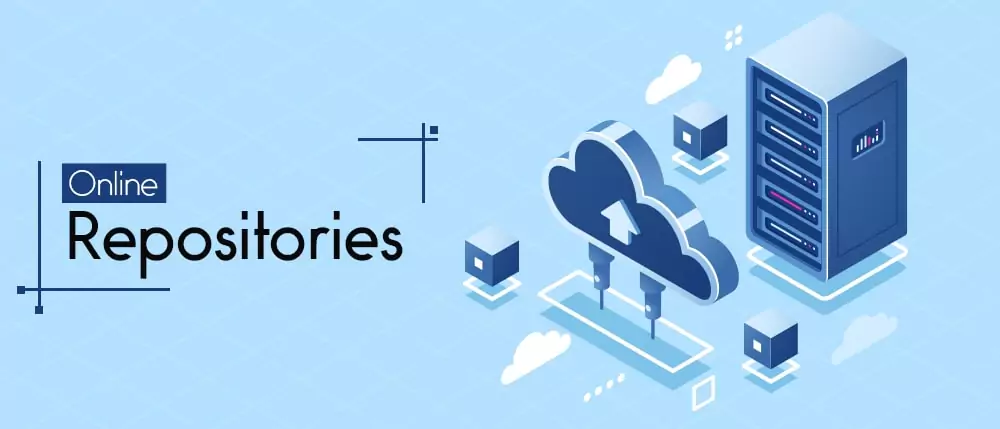
These are online sources like WebMD, Mayo Clinic and more that offer a repository of health information on a number of ailments. They are moderated and authored by qualified professionals who are subject matter experts. These repositories offer information on simplest ailments such as acnes to complex and severe ailments like brain tumour and cancer.
Personal Health Records
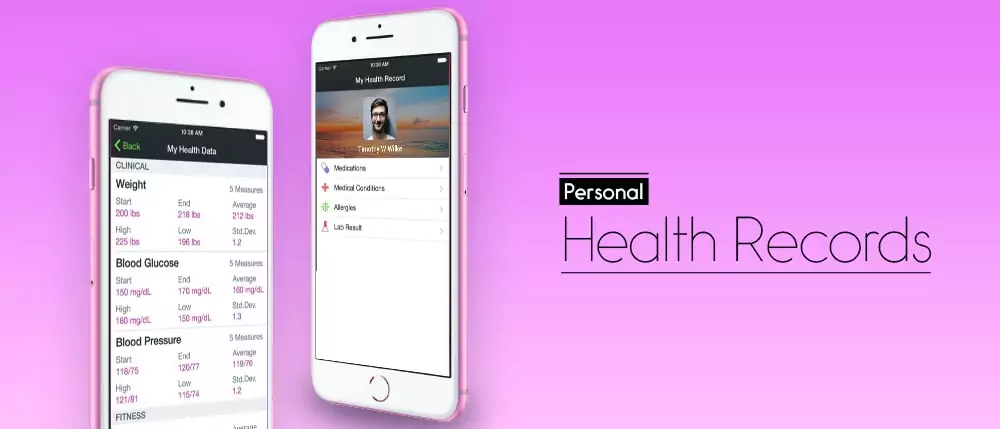
It’s very similar to an electronic medical record. But it majorly differs from an EMR in the fact that your personal health record cannot be accessed by any healthcare provider. This is an online portal where you are offered space to fill and maintain your personal health record and insights. It could be soft copies of your bills, reports and prescriptions or just their digital versions. These allow you to retrieve and go through them whenever you want to track progress and changes.
Patient Portals
A patient portal is every detail you have in your EMR plus additional functionalities like the ability to call and connect with your doctor, schedule appointments, get consultations, review and view bills, pay online and more.
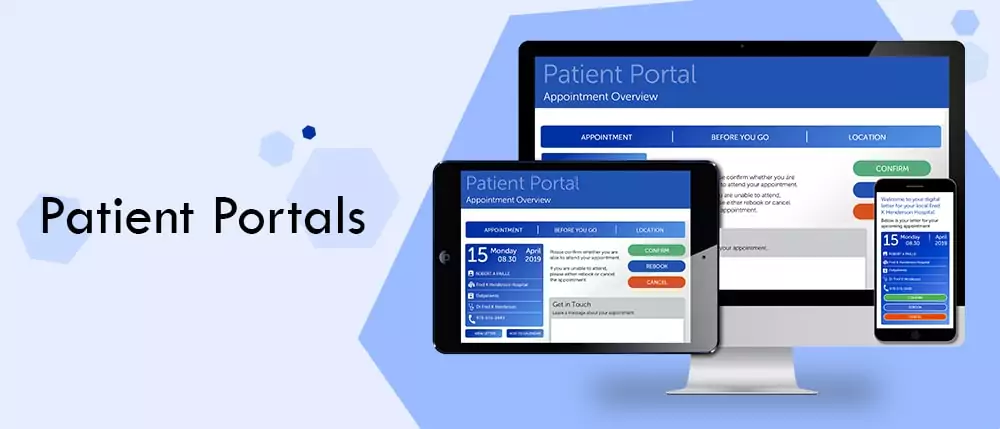
These are quick alternatives to phones and conventional mediums and reduce the time required to execute any healthcare-based action. These could be used from personal computers, smartphones and tablets. This fosters transparency, improves billing, saves time, and brings everyone on the same page.
Data and Information Transmission
Data and information transmission refer to the capability of information being imported to or exported from other applications such as tethered applications that are linked to the health records of a specific healthcare provider’s system. These systems allow patients to view their electronic health records but not modify them as they are owned and accessed by a different stakeholder. Some apps even allow patients to communicate with them from wherever they are. Some of the details stored in this system include:
- Personal details
- Contact information
- Health provider information
- Health conditions list
- Medical history
- Medication history
- Specific allergies
- Immunizations
- Lab tests and their results and more

Telehealth is a brilliantly booming segment. Statistics reveal that by 2025, it is anticipated to become a $64.1bn market in the US alone. Globally, it is expected to be worth $130.5bn.
In 2017 alone, over 76% of the hospitals in the US connected with their doctors and patients through videos.
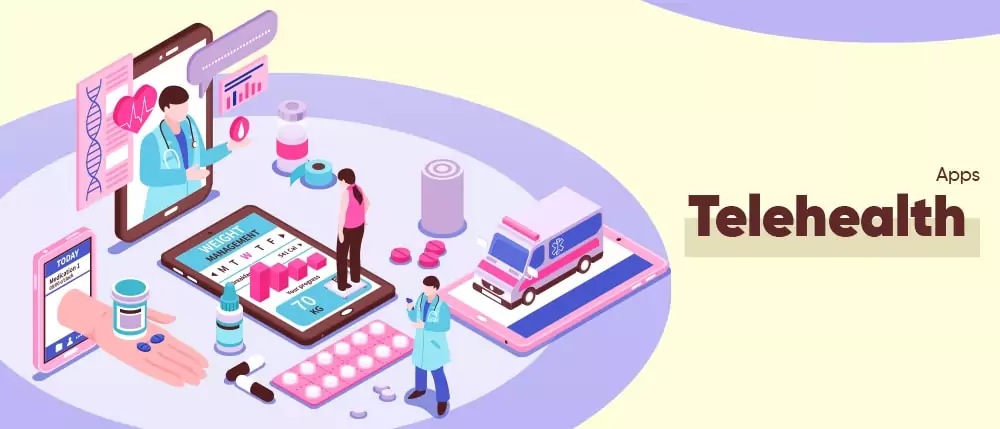
That’s a numerical representation of the prominence of telehealth. If you’re still unsure of what it is, understand that it is the use of tele-centric mediums such as smartphones, apps and phones to avail healthcare.
This includes remote consultations with doctors and clinics, remote payments, remote diagnosis, using an app to assess blood sugar levels, receiving texts on scheduled appointments and more.
There are two aspects to telehealth and let’s look at them.
Telemedicine Virtual Visits
This is the use of video conferencing features and the functionalities of latest devices to find and connect with specialists near you and get consultations from your home. In cases of emergencies and pandemics, this is ideal as patients need not be taken outside of their homes and still receive top-class treatments, consultations and diagnosis.
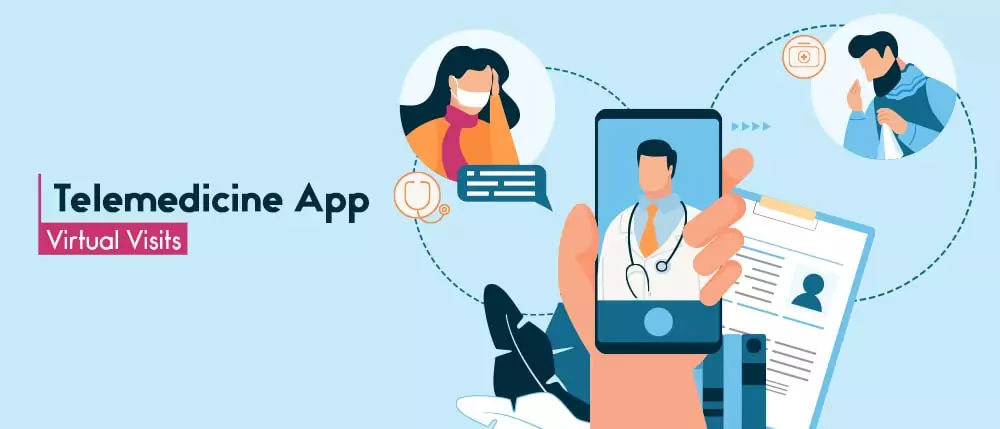
Virtual visits also involve chatting via text on on-demand healthcare apps with specialists and qualified physicians onboarded on the portal. These are not extensive but quick connected patients could talk about getting insights on minor ailments.
Telehealth is more than a concept. It’s a proven operating mechanism that has shown an adoption rate of over 340% in the year 2019 alone.
Remote Care Programs
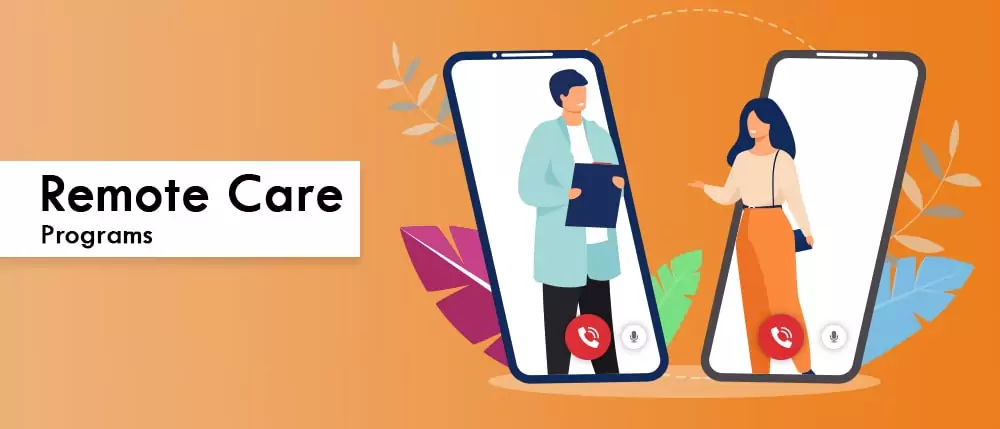
This facilitates the generation, recording and transmission of everyday biometric data, health assessment information and monitoring of changes in any health patterns. To keep all stakeholders (patients, caretakers and family) in the circle engaged, they are given access to guided health sessions, interactive education, video conferencing and other features.
Decision Support Software
Decision Support System (DSS) is a common term in the business spectrum. It involves the use of data and information to make informed business decisions. This concept has been borrowed from the business industry and implemented in healthcare and called Clinical Decision Support System (CDSS).
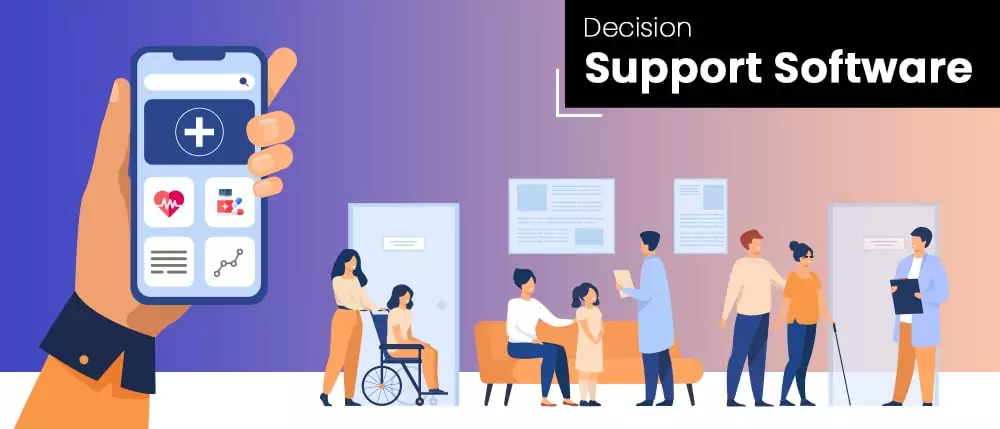
Similar to its business application counterpart, CDSS involves the use of healthcare data and insights to improve patient care and treatments.
It helps streamline knowledge, patient information, integrate workflows, optimize coordination between stakeholders like diagnostic centres and clinics, offer better healthcare assistance and more.
The purpose of CDSS can be classified into two:
Independent Clinician Review, where insights about a patient and their medical history is available at quick disposal for informed and precise treatments. Such records include information such as
- Preventive care reminders
- Notifications about lethal drug interactions with allergies and human conditions
- Updated testing and their reports and more
Does not make recommendations that the user could not find through channels other than the software, that provides a set of questionnaires to study a patient’s level of stress and anxiety before any diagnostic process of general anxiety disorders. Based on the answers and insights generated, treatment charts are laid out. A software application backs the caretakers of pediatric patients with ailments such as cystic fibrosis by collating insights on when they should be brought to emergency rooms based on specific symptoms and care guidelines.
Enterprise Support
Large scale healthcare providers like prominent hospital chains require equally large software applications that could take care of the mammoth processes and tasks involved. They require agility and scalability like no other.
Fortunately, there are several applications built for growth and expansion and offer an agile operating environment. These remove all the complexities involved in running the hospital and allow staff to focus more on patient care.
Apart from administrative tasks, enterprise support is also extended to tasks like:
Clinical trial and management, where custom-built software applications are used by bio and pharma companies to efficiently manage clinical trials and research.
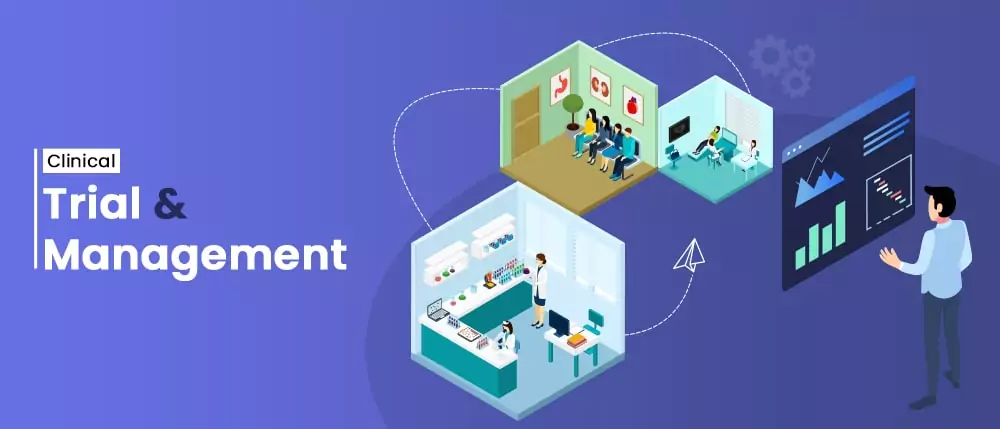
Trial management software , where processes involved in clinical trials are seamlessly scheduled, maintained and recorded by these systems. The intricacies involved in running clinical trials such as batch information, patients information, test results, the dosage and chemical details of the drug provided and more. These tools allow stakeholders to immediately visit previous trials to make appropriate modifications as well.
Trial recruitment platforms, where patients volunteering to be part of the trial are segmented and reached out to through automated systems, messages for the need for new volunteers are sent out, eligible volunteers are segregated and those who don’t are moved to repositories for contacting in the future and more.
Clinical Care Administration and Management Tools
On the other end of the spectrum of mega hospitals and treatment centres are small and medium-sized clinics. The requirements of these clinics are very different from that of hospitals because of their size, specializations and volume of patient footfall. So, the tools and applications they deploy vary in their functionalities as well.
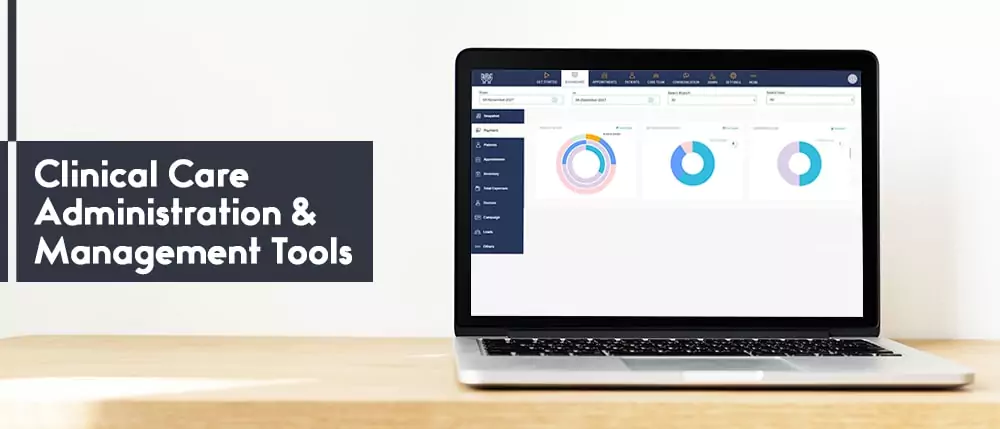
A typical clinical care management tool involves the following:
Revenue cycle management tools, where aspects of revenue generation, management and budgeting are taken care of by the portals. These help stakeholders get insights on revenue generated in each department or wing, where improvements can be made, what process can be optimized for reduced expenses, payment systems integrations and more.
Clinical staffing, which involves recruiting, training and retaining staff for the clinics. Attrition is a major challenge in clinics and airtight systems and applications provide insights and ways to optimize staffing. Adequate staffing paves the way for positive morale, better patient care and a healthy clinical environment. They also help in automation of duty rosters, payroll management, leave and compensations and more.
Length of Stay monitoring tools, where the duration of stay of each individual patient is recorded on portals. With each extended day, it’s not just the expenses on the bed that are incurred but the costs on surgical equipment and medication, too. These tools actively record the administration of drugs such as drips, insulins, injections, oxygen cylinders, diet and more and bill them accordingly.
Digital Therapeutics: Preparing For Take-off
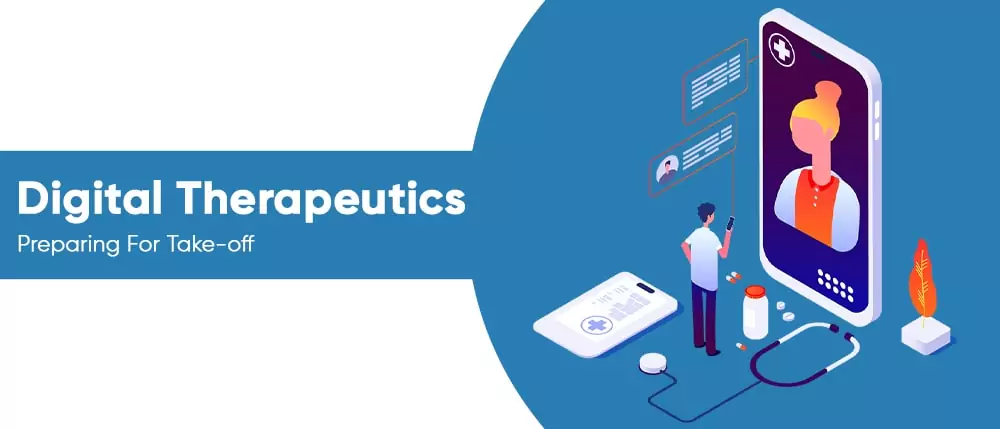
Though healthcare has advanced at significant proportions, there are still some diseases and chronic ailments conventional health care cannot cure or help patients tackle. Be it diseases like Multiple Sclerosis or any neurological disorders, there are areas conventional treatment practices have shown zero results for resolutions.
Entering such uncharted territories with better treatment scopes is digital therapeutics. In layman terms, digital therapeutics is the introduction of digital devices to replace conventional medicine or treatment procedures to tackle certain diseases and disorders.
On paper, they require less expenses from the patient's side as they relatively reduce dependencies on drugs and medications. They also significantly reduce clinical visits and consultations. As of now, digital therapeutics have intervened and offered solutions through mobile applications to fight alcohol and drug addictions. They are also being increasingly sought to treat mental illnesses like depression and insomnia.
Despite being promising, digital therapeutics is considered underprepared to enter mainstream healthcare primarily because of two reasons:
- They are yet to be clearly defined and distinguished from lifestyle and wellness markets
- The misalignment of incentives in the healthcare chain
Besides, there are tons of regulations and compliances involved in digital therapeutics, incorporation of SOPs and best practices, benchmarks and protocols, study of real-world outcomes, bringing in privacy standards and data usage policies and more.
However, digital therapeutics is increasingly gaining patronage and support from the healthcare sector and is seen as a probable future in treating certain ailments and diseases. Wireless devices, sensor-based equipment, applications, wearable tech are increasingly being worked on to make digital therapeutics more airtight. Reports estimate that by 2024, the digital therapeutics market will be valued at around $580mn.
Future of Digital Health
The future of digital health is all about evolution and adopting trending practices and tech concepts. Let’s start with digital therapeutics, where the foundations have already been laid. There are virtual reality programs deployed to help soldiers deal with trauma and physical pain. Video games have been studied to improve cognitive skills and biofeedback can reduce stress.
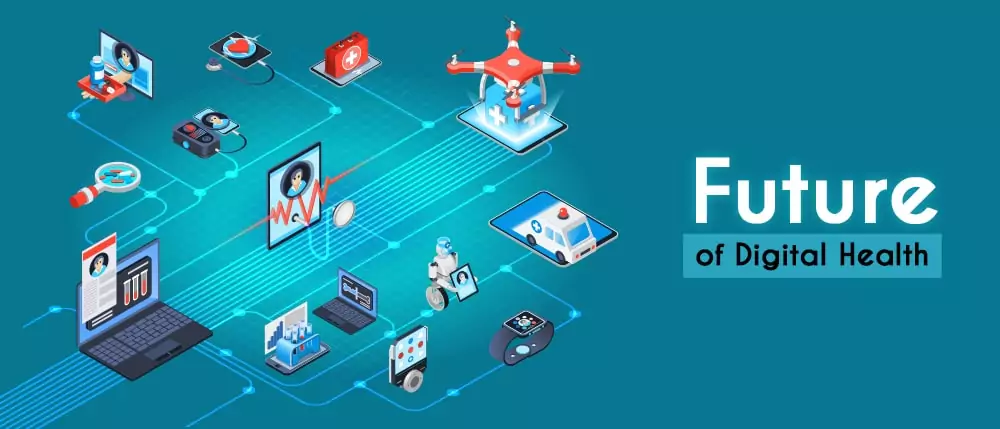
Standing here, we could see a new world where conventional therapies are replaced by digital therapeutics that are more goal driven.
Apart from this, data will be at the centre of all operations in healthcare and it would continue to gain prominence. More intense applications will be built using artificial intelligence, machine learning, deep learning and more. They will also be commercialized for consumer usage, pushing healthcare further.
Clinical management tools, enterprise software apps will become a norm in organizational management as well.
This is an exciting time in the evolution of healthcare. With organizations waking up to digitization right now, this would be the most ideal time to invest in getting a custom digital health software developed.
If you have always had such thoughts in mind, it’s time to turn them into reality. Get in touch with us today to learn more about how you can get a solid digital health app developed the market deserves.